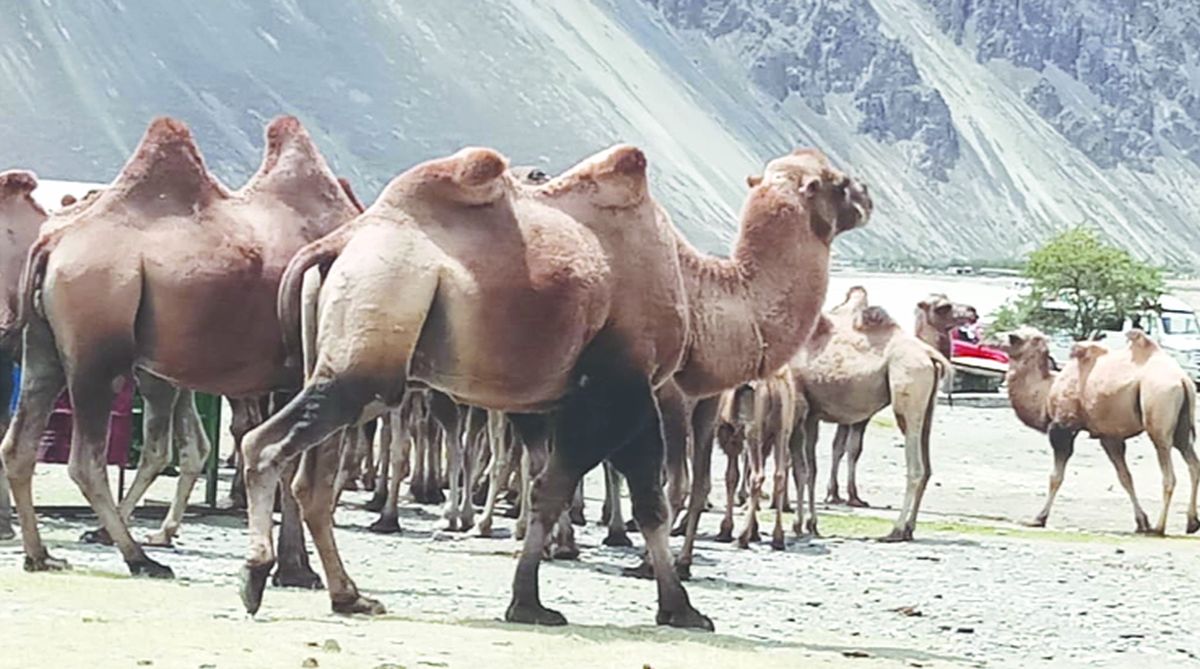In good news for animal lovers and activists, the double humped camel of Ladakh that was till a few years ago heading towards extinction, is now expected to touch the figure of 200 in the national stock census that will be completed by the end of September.
The rare species of double humped camel is found in India only in Ladakh’s Nubra valley where the population of the animal had dropped to only 36 about ten years ago and it was struggling for its survival.
The present population of this species of camel is 166 and is expected to go up to about 200 in the fresh census, said Dr Mohammad Iqbal, chief veterinary officer of Leh.
The district authorities had two years ago prepared an action plan for conservation of the rare species but the project report was not forwarded to the Central government by the state authorities and the entire responsibility of protecting the animal was on individual owners.
A national research centre for the traditional single humped camel has been established in Bikaner, Rajasthan, but no such initiative has been taken for conservation of the double humped camel of the cold desert.
The double humped camel is used as a tourist attraction in the Hunder, Sumoor, Diskit and Tigger areas of the Nubra valley where the owners charge a sum of Rs.300 for a 15 minute ride and provide a photo-shoot opportunity to tourists whose footfall has increased in Ladakh.
The sand dunes festival at Hunder in July attracts a large number of tourists who enjoy the ride on the double humped camels during the two-day festival.
Iqbal said the department was keeping an eye to prevent cruelty towards the camel and has built two brick-stands at Hunder and Diskit to enable tourists to ride the animal without making it sit and stand on the ground.
The Indian Army has for the first time initiated a pilot project to introduce the double humped camels for patrolling the Line of Actual Control (LAC) with China to check intrusion in Ladakh.
The concerned wing of the Army acquired four double humped camels last year for training them and their number has increased to six with the birth of two calves, said Iqbal. Two single humped camels have also been acquired by the Army from Bikaner and the results are awaited.
Urbanisation was one of the main reasons for the dwindling population of the rare species. A good number of double humped camels would be seen on the streets of Leh a couple of years ago, but due to urbanisation and modern means of transportation reaching there the camels were shifted to the Nubra valley.
The Army is training the double humped camel not only to patrol the LAC but also carry 180 to 220 kg load of ammunition, rations and other supplies in the inhospitable terrain.
The double humped camel can survive even in the harsh winter when the temperature dips to -40 degrees Celsius in many areas of Ladakh. The mules being used for this purpose carry about 40 kg of load.
The largest population of double humped camel is in the Hunder village followed by Sumoor, Diskit and Tigger.
The species is a native of the Gobi desert spread across Mongolia, China, Kazakhistan, Turkmenistan, Uzbekistan and also parts of Afghanistan.
While population of the species had alarmingly dwindled in India, its population the world over is around 8.44 lakh with China leading with 2.70 lakh double humped camels followed by 2.60 lakh in Mongolia, 2 lakh in Kazakhistan and 1 lakh in Russia. The species has almost become extinct in Kyrgystan where its population has been recorded at only 50.











